

 |
 |
 |
Guest - Not logged in | ||||||||||||||||||||||||||||||||||||||||||||||||||||||||||||||||||||||||||||||||||||
Reviews > Footwear > Boots > Xero Shoes DayLite Hikers > Test Report by Kurt PapkeXeroShoes DayLite Hiker
| |||||||||||||||||||||||||||||||||||||||||||||||||||||||||||||||||||||||||||||||||||||
| Name |
Kurt Papke |
| Age |
64 |
| Gender |
Male |
| Height |
6' 4" (193 cm) |
| Weight |
225 lbs (102 kg) |
| Email address |
kwpapke at gmail dot com |
| City, State, Country | Oro Valley, Arizona USA |
| Product
Information |
||
| Manufacturer |
Xero Shoes |
|
| Manufacturer website |
https://xeroshoes.com |
|
| Year Manufactured |
2017 |
|
| Size tested/used |
13 men's Available in sizes Medium 6.5-13 |
|
| Color tested/used |
Black/yellow.
Also available in Black and Mesquite (brown) |
|
| MSRP |
USD $109.99 |
|
| Listed |
Measured |
|
| Weight (one shoe) |
10.2 oz (289 g) for size 9 |
13.1 oz (371 g) for size 13 |
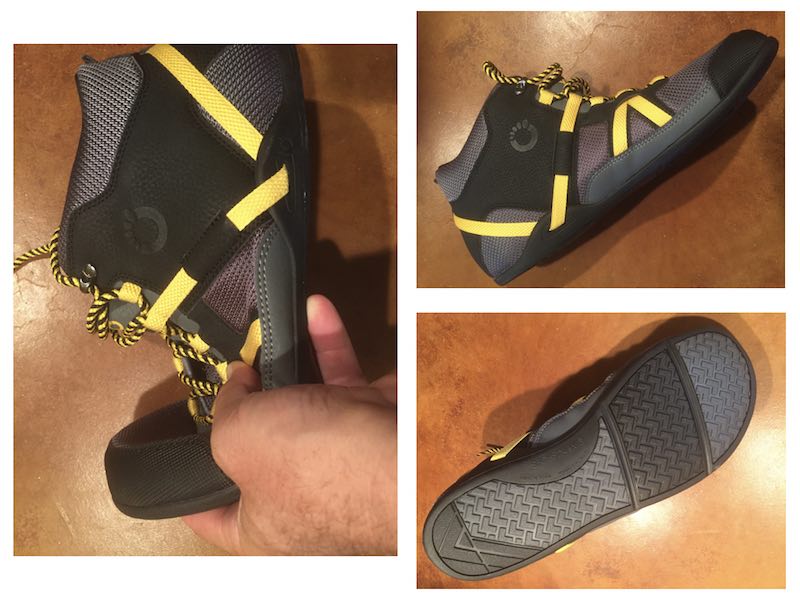
| Date |
Location |
Trail |
Distance |
Altitude |
Weather |
Total Pack weight with
Food and Water (approximate) |
| November 10-13, 2017 |
Gila Wilderness, New Mexico |
West/Middle
Fork Loop |
43 miles (69 km) |
5630-7450 ft (1716-2271 m) |
Sunny and unseasonably warm, highs around
70F (21 C), nightly lows to 25F (-4 C) |
35 lbs (16 kg) |
| Various |
Tucson, Arizona |
Local dayhikes |
5-9 miles (8-14 km) |
Various |
Sunny and unseasonably warm | N/A |
| December 10-13, 2017 | Grand Canyon National Park, Arizona | Hermit
and Tonto |
27 miles (43 km) |
2800-6640 ft (850-2024 m) |
Highs around 60 F (15 C), lows near 25 F (-4 C), sunny with light wind | 40 lbs (18 kg) |
Four-day hike up the West Fork of the Gila, over the mountains
and down the other side, then back up the Middle Fork to Little
Bear Canyon where I crossed back to my starting point. This
is probably the worst possible test conditions for footwear: the
shoes are brand new (I didn't break them in), periodic stream
crossings keeping shoes and socks soaking wet, and a
sandy/gritty environment. My pack weight was fairly
modest, as I carried a lightweight hammock and only 1 L (1 qt)
of water.
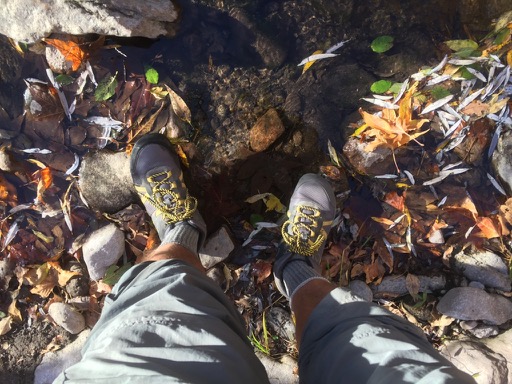 The DayLite Hikers went on easily and laced up
with no issues. I wore midweight merino wool socks inside
the shoes, socks that I have worn for many years without any
issues. I set off on my first (short, i.e. started at
1:30pm) day full of enthusiasm. The first couple of miles
(few kilometers) were nice and dry. Then the Gila River
crossings began and continued incessantly for the rest of the
afternoon. See photo at left for the last moments of the
shoes before they got wet. That was the very first of
about 20 stream crossings that day.
The DayLite Hikers went on easily and laced up
with no issues. I wore midweight merino wool socks inside
the shoes, socks that I have worn for many years without any
issues. I set off on my first (short, i.e. started at
1:30pm) day full of enthusiasm. The first couple of miles
(few kilometers) were nice and dry. Then the Gila River
crossings began and continued incessantly for the rest of the
afternoon. See photo at left for the last moments of the
shoes before they got wet. That was the very first of
about 20 stream crossings that day.
Traction in the stream crossings was a little sketchy. The fist-sized rocks that make up the stream bottoms were quite slippery, and the DayLite Hiker soles did not grab the rocks at all. The good news is I managed to not fall and get wet or hurt!
When I made camp that night I noticed a little hotspot on the tips of the toes of my right foot, but didn't think anything of it. I hung the shoes and socks out on a tree limb overnight to dry after removing the insoles from for better ventilation.
In the morning the shoes were still quite wet, despite the dry weather. I decided to do the rest of my river walking that morning in sandals (Xero Amuri Venture) that I had brought for camp shoes in an attempt to get the DayHikers to dry out overnight. About 1PM I hit Hells Hole canyon and dry ground, had lunch, and switched back into the DayHikers. I hiked until about 5PM and called it a day. The toes on my right foot were throbbing, so I thought I better have a look. Horrors! A large blood-filled blister on the tip of the third toe and smaller blister on the fourth toe, both extended underneath the toenail. It has been many years since I had blisters this bad. I got out my knife and lanced both of them so they could dry and heal overnight.
Both toes were pretty sore in the morning, and I had a big descent to do first thing, so thought it best to keep pressure off the toes and wore my sandals. In fact, the DayLight Hikers remained strapped to my pack for the rest of the trip.
I did not include a photo of my toes in my report, as they looked pretty gross. I think I'm going to lose the nail on the third toe (I did). The shoes are plenty big enough, they are a full size larger than my feet. I think the issue is I have wide toe splay, and the shape of the DayHiker toe box doesn't match my toe lengths very well. The toe box is also not very high, and I think my (freshly-trimmed) toenails were rubbing against the top of the toe box.
After my feet heal I'll try wearing the shoes again, but this time with thinner socks and no insole to give my toes as much room as they can get.
Not a very auspicious beginning!
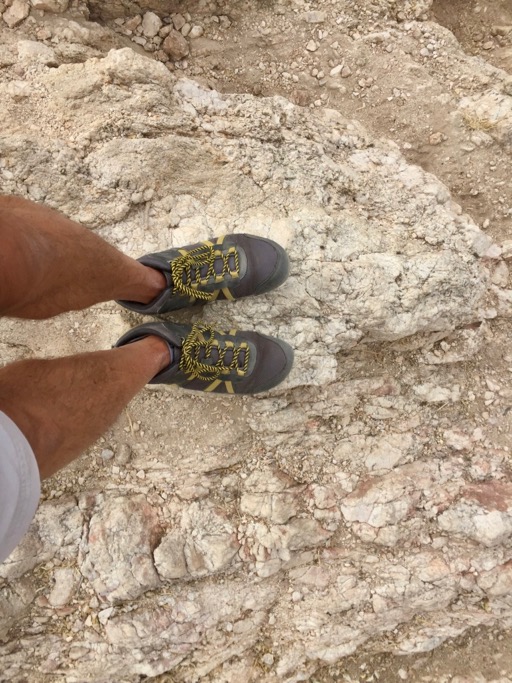 My first shoe use after the Gila was a
dayhike up Wasson Peak. I removed the insoles and wore
lightweight Merino toe socks (Injinji). Success! No
toe damage. Like the Gila hike, this trail is very rocky
so my feet were pretty tired when I was done, so it was a good
test.
My first shoe use after the Gila was a
dayhike up Wasson Peak. I removed the insoles and wore
lightweight Merino toe socks (Injinji). Success! No
toe damage. Like the Gila hike, this trail is very rocky
so my feet were pretty tired when I was done, so it was a good
test.
Next up was a 5 mile (8 km) training dayhike up Romero Canyon in the Santa Catalina Mountains near Tucson, AZ. No insole again, this time with low-cut Injinji socks (see photo at left). My ankles rubbed a bit with the short socks; these shoes don't strike me as being usable sockless. This is also a rocky trail that gains/loses altitude quite quickly, so its a good test of the DayLite Hiker traction, and they performed flawlessly.
A few days later I did 7 miles (11 km) on the Pima Canyon
Trail, again in the Santa Catalina Mountains. I used
Coolmax liner socks that came up over the top of the shoes. I
figured the thin socks would give me plenty of space, and they
did. The only issue I had was the socks looked pretty
dirty after a 4 hour hike, though it is a very dusty
trail. Seems like a fair amount of dirt can make its way
into the shoes.
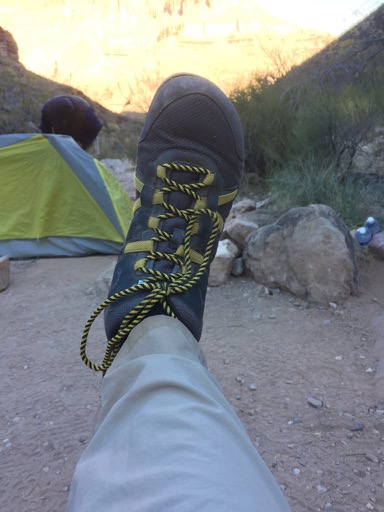 Four-day, three night backpack in the
western portion of the Grand Canyon. Winds were light, but
temperatures dropped to freezing and below as soon as the sun set
every night. The terrain was a mix of rocks, gravel and
dirt. I wore Injinji toe socks every day, a pair of thin
synthetics, or a pair made of thicker merino wool depending on
temperatures. My pack weight was a bit heavier due to a
larger pack, 2 person tent, and typically carrying 3 L (3 qt) of
water plus a liter (quart) of Scotch whiskey. The latter was
shared by 3 people over the 4-day hike just to be clear!
Four-day, three night backpack in the
western portion of the Grand Canyon. Winds were light, but
temperatures dropped to freezing and below as soon as the sun set
every night. The terrain was a mix of rocks, gravel and
dirt. I wore Injinji toe socks every day, a pair of thin
synthetics, or a pair made of thicker merino wool depending on
temperatures. My pack weight was a bit heavier due to a
larger pack, 2 person tent, and typically carrying 3 L (3 qt) of
water plus a liter (quart) of Scotch whiskey. The latter was
shared by 3 people over the 4-day hike just to be clear!Not everyone is ready for minimalist shoes of this type, but my
feet are pretty tough and I enjoy wearing them. I was
carrying pretty substantial pack weight on the overnight trips,
and I didn't notice any material difference in foot fatigue due
to the additional weight. I do like the good "feel" my
feet have for the trail when wearing the DayLite Hikers.
| Date |
Location |
Trail |
Distance |
Altitude |
Weather |
| Feb 1-5, 2018 | Grand Canyon National Park, Arizona | Tonto
and Boucher |
38 miles (61 km) |
2760-7200 ft (840-2195 m) |
Highs around 70 F (15 C), lows near 32 F (0 C), sunny with light winds |
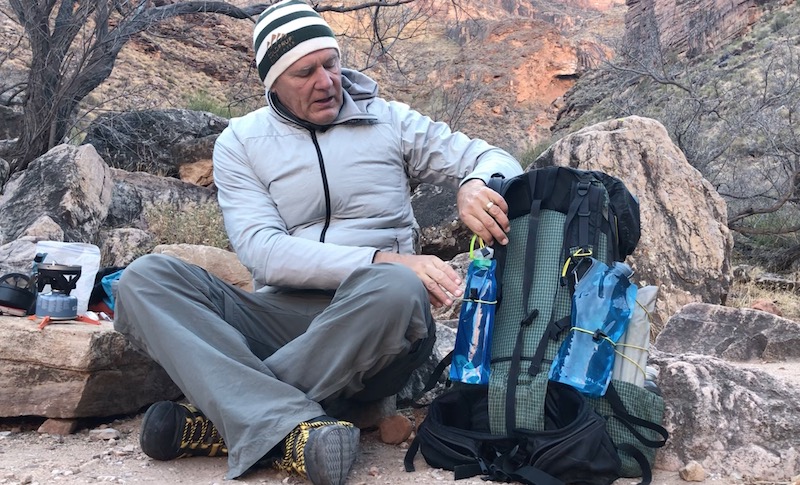
This was a "check the box" solo hike of five days and four nights, designed to complete the last of the Grand Canyon trails I had yet to tread. I descended from the South Rim along the South Kaibab, and cut over along the Tonto trail all the way to Boucher Creek. From there I ascended on the Boucher and Hermit trails. I have now completed all the Grand Canyon trails from the Little Colorado confluence to the Boucher Creek area with the exception of New Hance.
The weather cooperated with my plans, I had near perfect
conditions with daytime temperatures warm enough to hike in
short sleeves, and nighttime temperatures hovering just above or
at the freezing point. The above photo was taken at about
9AM while the sun was still below the canyon walls, so I was a
little chilly. Apparent in the photo: my DayLite Hiker
shoelaces were untied - this was something I often did in camp
for comfort.
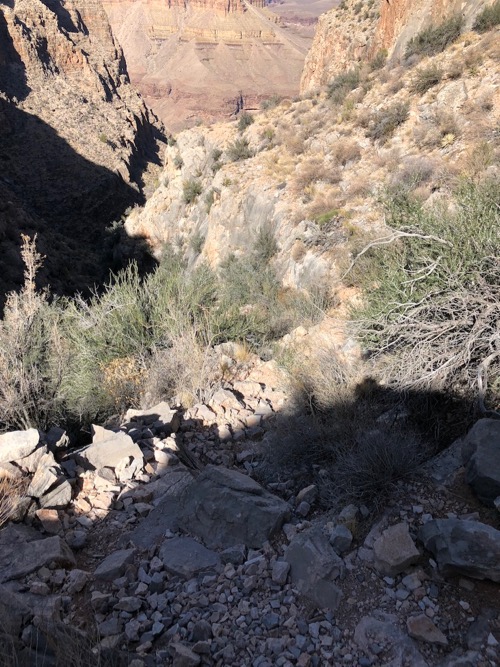 Trail conditions were mixed: the South
Kaibab and Tonto trails were in pretty good shape, but the
Boucher trail, reputed to be the most difficult and dangerous in
the Grand Canyon was overgrown, rocky and incredibly steep.
Trail conditions were mixed: the South
Kaibab and Tonto trails were in pretty good shape, but the
Boucher trail, reputed to be the most difficult and dangerous in
the Grand Canyon was overgrown, rocky and incredibly steep.
The photo at left was taken about 1/2 way up my Boucher
ascent. Just below the top of the photo is the canyon I
started at earlier in the morning. The canyon bottom is
just below the lip of the ridge, so not truly visible. At
the bottom of the photo is a sample of the "trail", if you can
call it that. The picture does not do justice to the
challenges of this trail, as a 2-D picture simply cannot capture
the scale of the terrain.
The good news is I did not fall once on the Boucher
Trail. The DayLite hikers functioned passably well under
these difficult conditions. They did extremely well
grabbing bare rock, but did not do very well with gravelly
sections where they had a tendency to slide due to the lack of
aggressive lugs. I noticed that my socks had copious
amounts of Grand Canyon Redwall dust on the outside when I took
the shoes off at the end of the day and shook my socks
out. The shoes keep small pebbles out nicely, but allow
lots of dust through the breathable uppers.
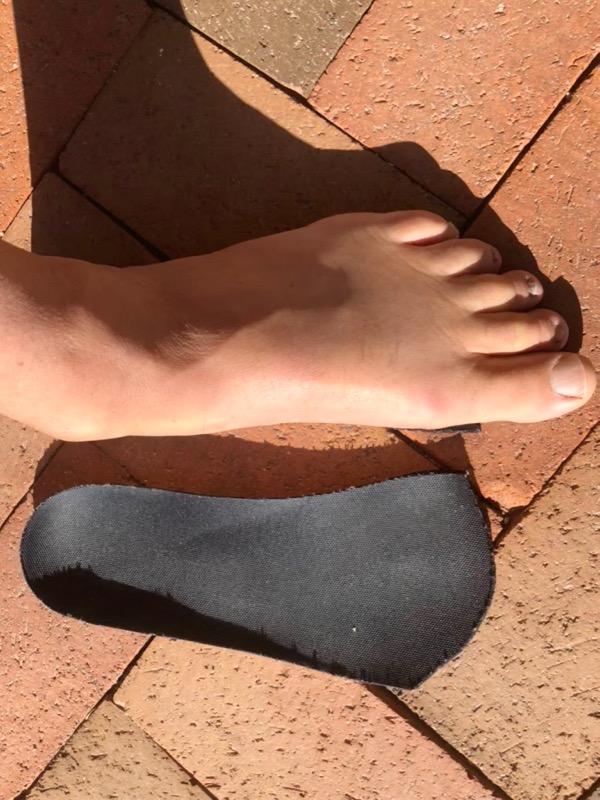 Before departing on this trip I cut the tips off the
insoles - I wanted protection for my heels, but wanted maximum
space for my toes (see photo at left). They were quite easy
to cut with kitchen shears. I cut them right where my
forefoot transitions into my toes - that way my foot surface would
get the full padding from the insole.
Before departing on this trip I cut the tips off the
insoles - I wanted protection for my heels, but wanted maximum
space for my toes (see photo at left). They were quite easy
to cut with kitchen shears. I cut them right where my
forefoot transitions into my toes - that way my foot surface would
get the full padding from the insole.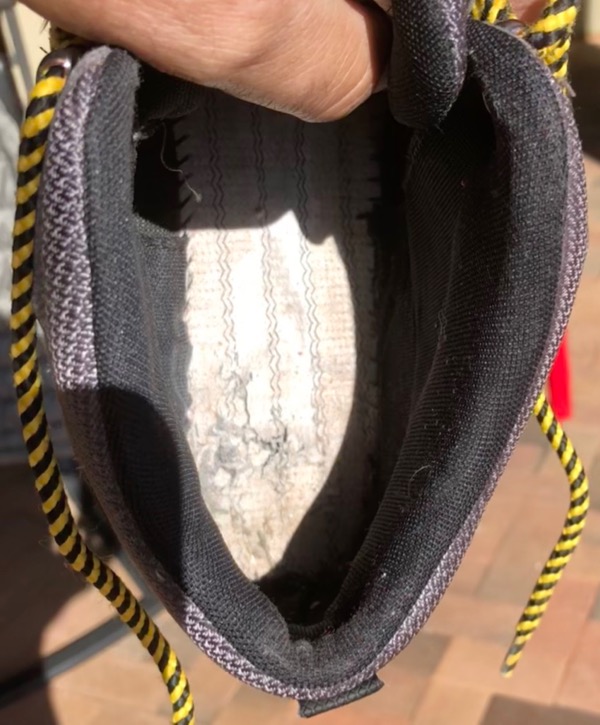 After my return and running them through the washing
machine I took the insoles out and put the shoes in the sun to
dry. I was surprised to see severe wear in the sole fabric -
it is literally falling apart. See photo at right. For
now this is just a cosmetic issue, the sole bottoms show no wear
at all, so it's not an issue that my feet are going to pop out of
the bottom of the shoes. I can feel the deteriorated fabric
with the soles of my feet if I am wearing thin socks - it is
noticeable. It is possible this wear occurred while I was
wearing the shoes with no insoles, the friction of my feet rubbing
on the shoe bottom and wearing the fabric.
After my return and running them through the washing
machine I took the insoles out and put the shoes in the sun to
dry. I was surprised to see severe wear in the sole fabric -
it is literally falling apart. See photo at right. For
now this is just a cosmetic issue, the sole bottoms show no wear
at all, so it's not an issue that my feet are going to pop out of
the bottom of the shoes. I can feel the deteriorated fabric
with the soles of my feet if I am wearing thin socks - it is
noticeable. It is possible this wear occurred while I was
wearing the shoes with no insoles, the friction of my feet rubbing
on the shoe bottom and wearing the fabric.The Xeroshoe DayLite hikers can be used for extensive
backpacking in challenging conditions, providing the hiker has
conditioned their feet, ankles and calves to stand up to the
challenge. They feel a little bit like hiking in
moccasins. The soles have proved to grip dry bare rock
quite well, but do not do so well when wet. Due to the
lack of aggressive sole lugging, their performance in gravelly
conditions is modest. The laces are wonderful - easy to
see and tie, and they stay taut all day long without double
knotting. They have a pretty good KSO (Keep Stuff Out)
factor - they can be used without gaiters and remain free from
pebbles. They are permeable against dust, and my socks
were very dirty at the end of every day.
The sole bottoms have shown almost no wear. The laces, uppers and inner soles have started to show wear and tear beyond what I would expect for the use they were subjected to.
I intend to continue to use the DayLite Hikers on backpacking
trips and day hikes where the trail is reasonably well
maintained and not too rocky. For instance, on my last
Grand Canyon hike they were perfect for the South Kaibab trail,
as it is well-maintained. If I were to do a trail like the
Boucher again, I would probably leave them at home and go with
more foot protection.